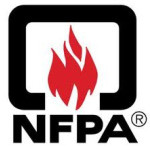- Industry: Fire safety
- Number of terms: 98780
- Number of blossaries: 0
- Company Profile:
Established in 1896, NFPA's mission is to reduce the worldwide burden of fire and other hazards on the quality of life by providing and advocating consensus codes and standards, research, training, and education.
The outermost component of an element or item not including trim, hardware, reinforcing material, pockets, wristlet material, accessories, fittings, or suspension systems.
Industry:Fire safety
The number of persons for which the means of egress of a building or portion of a building is designed.
Industry:Fire safety
The pipes supplying sprinklers, either directly or through sprigs, drops, return bends, or arm-overs.
Industry:Fire safety
The points on or around the aircraft or airport ramp where fuel can be released. These points include fueling hydrants, fuel servicing vehicles, fuel tank fill connections, fuel vent openings, and fuel dump valves.
Industry:Fire safety
The organization(s) responsible for the care and transport of sick and injured persons to an appropriate emergency care facility. Referred to as Emergency Services in U. S. federal confined space regulations.
Industry:Fire safety
The organizational level having responsibility for a major functional area of incident management, such as operations, planning, logistics, finance/administration, and intelligence (if established).
Industry:Fire safety
The most severe earthquake effects considered by this code as defined in ASCE/SEI 7, Section 11. 4.
Industry:Fire safety
The physical discharge or emission of aerosol as a consequence of the condensed aerosol generator’s actuation or operation of the dispersed aerosol agent container.
Industry:Fire safety
The portion of the total fire load under a given, specific fire scenario of a certain fuel package that would be expected to be released in a design fire incident (units: joules or Btu). This can include transit and/or passenger rail vehicle(s), luggage, fuel, and/or wayside facilities or structures, that, because of the fuel package configuration, separation, and combustion characteristics, would be expected to be released in a design fire incident.
Industry:Fire safety
